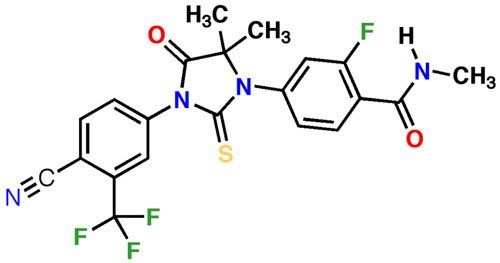Enzalutamide Delays Need for Chemo in Metastatic Prostate Cancer
Androgen inhibition with enzalutamide significantly reduced the risk of disease progression and increased survival among men with previously untreated metastatic prostate cancer, according to the results of the phase III PREVAIL trial.
Chemical structure of enzalutamide

Androgen inhibition with enzalutamide significantly reduced the risk of disease progression and increased survival among men with previously untreated metastatic prostate cancer, according to the results of the phase III PREVAIL trial presented at the ASCO Genitourinary Cancers Symposium.
Men assigned to treatment with enzalutamide had a 29% reduced risk for death (HR = 0.706; P < .0001) and an 81% reduction in the risk of radiographic disease progression (HR = 0.186; P < .0001) compared to patients assigned placebo.
In addition, the drug slowed or stopped cancer growth in almost 60% of men assigned the therapy, delaying the need for chemotherapy by 17 months.
“Enzalutamide was well tolerated over a prolonged period of time,” said Tomasz Beer, MD, FACP, professor of medicine and deputy director of the Knight Cancer Institute at Oregon Health and Science University. “It is my view that it provides a meaningful clinical benefit to men with metastatic prostate cancer.”
Enzalutamide, a second-generation androgen receptor antagonist, was approved by the FDA in August 2012 for the treatment of men with castration resistant prostate cancer who had progressed after prior docetaxel chemotherapy in the phase III AFFIRM trial.
This double-blind, placebo-controlled trial enrolled 1,717 chemotherapy-naive men to 160 mg per day enzalutamide or placebo. The researchers had co-primary endpoints of overall survival and progression of metastatic disease on imaging.
The study was stopped early in October 2013 by a Data Monitoring Committee because of the superior efficacy and overall benefit of enzalutamide to allow patients assigned to placebo the opportunity to receive the therapy.
At the time of the interim analysis, 28% of patients assigned enzalutamide and 35% of patients assigned placebo had died. The median overall survival in the enzalutamide arm was 32.4 months compared with 30.2 months for placebo. However, according to Beer, the majority of patients on trial are still alive and only 3.2% of patients who participated in the study are contributing data to median overall survival estimates. Median progression-free survival was not yet reached in patients assigned enzalutamide.
When looking at the time to chemotherapy, which Beer labeled as the most pragmatic measure of real world treatment effects, patients assigned enzalutamide had a 65% reduction in risk of chemotherapy, which at the median translated to a delay of 17 months. The median time to chemotherapy was 28 months for enzalutamide compared with 10.8 months for placebo (P < .0001).
Additionally, patients assigned to enzalutamide had a meaningful reduction in soft tissue disease viewed on imaging, with ten times as many patients assigned enzalutamide achieving an objective response than patients on placebo (58.8% vs 4.9%; P < .0001). Twenty percent of patients on enzalutamide achieved a complete response and 39% achieved a partial response.
During his presentation, Beer pointed out that the observation period for data collection was three times longer for patients assigned enzalutamide “reflecting the treatment effect of enzalutamide” (16.6 months vs 4.6 months). Forty-three percent of patients on enzalutamide had grade 3 or higher adverse events compared with 37% of patients assigned placebo. However, only about 6% of patients in each arm discontinued therapy due to adverse events.
The researchers also examined adverse effects that occurred in more than 20% of patients on enzalutamide and were more than 2% different between the two arms. Using that definition the most common events were fatigue, back pain, constipation, and arthralgia. One patient in each arm had a seizure, but both patients were found to have a history of seizures that was not known to their enrolling physician at the time of study enrollment.
Commenting on the research, Charles J. Ryan, MD, professor of clinical medicine and urology at the Helen Diller Family Comprehensive Cancer Center at the University of California, San Francisco, said, “this treatment, should it change the regulatory status of enzalutamide, would open up the possibility of therapy to a very large group of patients who currently have only one or two treatment options available to them.”
Navigating Treatment Intensification in Metastatic Hormone-Sensitive Prostate Cancer
A patient case of a 50-year-old man with hormone-sensitive prostate cancer sparked a debate among oncologists regarding the best course of action.